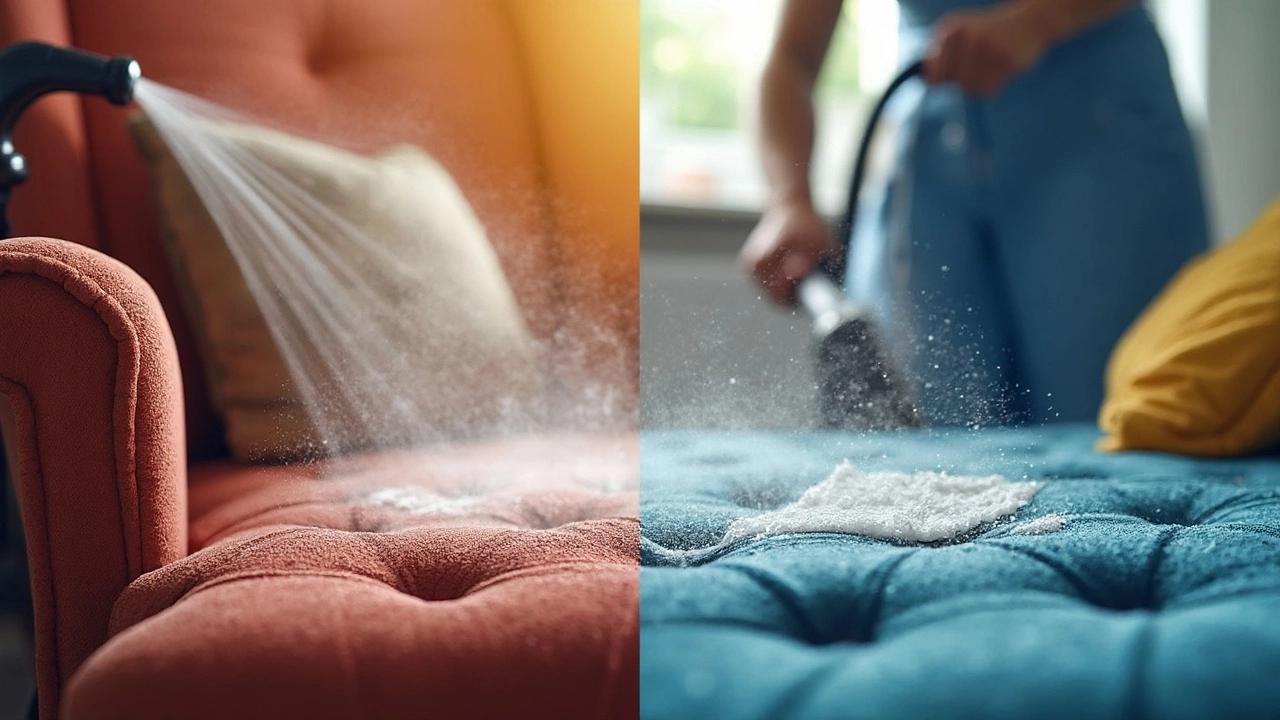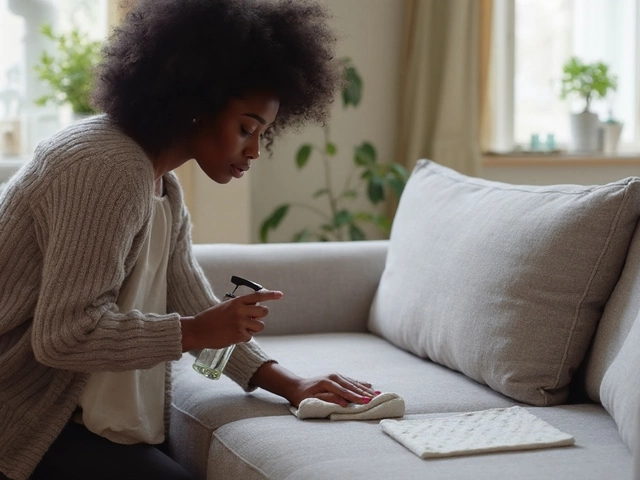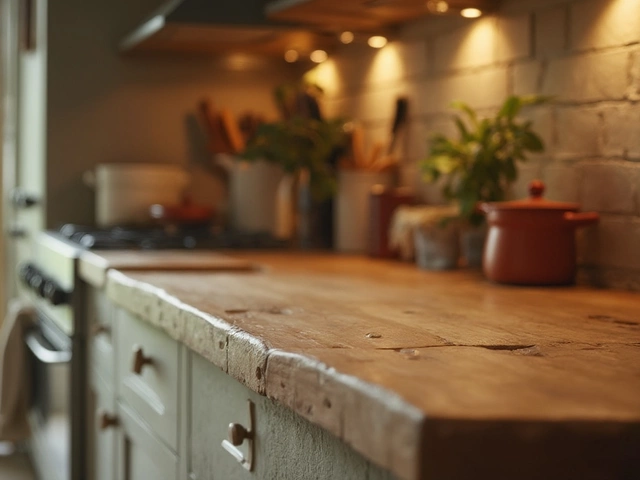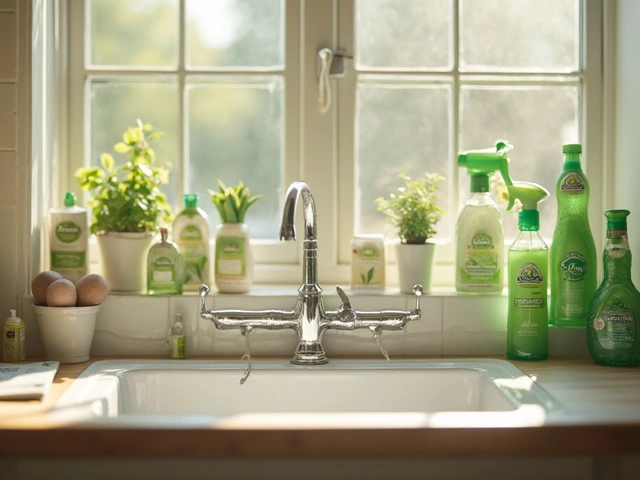Ever tried cleaning your couch and ended up with a bigger mess than you started with? Professional upholstery cleaners know all the tricks to avoid such headaches. They start by understanding the fabric. Not all couches are created equal, folks. Some fabrics can handle heat and moisture, others—not so much.
The tools of the trade are surprisingly simple yet incredibly effective. High-powered vacuums, steam cleaners, and specialized brushes make up an upholstery cleaner's toolkit. Have you ever heard of a vacuum with a beater bar? It's not just for carpets; it can work wonders on sturdy upholstery.
But let's talk about the magic potions—cleaning solutions. Forget the fancy labels; sometimes, it's all about eco-friendly options that are gentler on fabrics and still tough on stains. Upholstery cleaning requires the right touch. Aggressive chemicals can ruin fibers instead of rejuvenating them.
- Understanding Upholstery Fabric
- Essential Tools for the Job
- Effective Cleaning Techniques
- Spot Cleaning Like a Pro
- Eco-Friendly Cleaning Solutions
- Maintenance and Prevention Tips
Understanding Upholstery Fabric
Before diving into cleaning, getting to know your upholstery fabric is like unlocking its secrets. Different materials need different treatments, and well, not all furniture can handle a standard clean. That's why professional cleaners will always check the fabric type first.
The Fabric Types
You've got your naturals, synthetics, and blends. Natural fibers like cotton and linen are breathable but absorb stains quickly, so they need gentle cleaning. On the other hand, synthetic ones like polyester and nylon are stain-resistant but may not hold up to heat well.
Then there are blends—those tricky combinations like polyester-cotton. They require mixed methods of cleaning because they inherit traits from both types of materials.
How to Identify Your Upholstery
Usually, there's a tag or label with care instructions—not always exciting reading, but totally worth a gander. Some codes are common: 'WS' means you can use water or solvent-based cleaners, 'S' means skip the water and stick to solvents, and 'X' means vacuum only. Knowing this can save you a world of trouble!
Why It Matters
Missteps in identifying fabrics can lead to discoloration, shrinkage, or damage. Think of it as caring for a fancy dress; specific cleaning techniques suit specific fabrics. Professionals avoid one-size-fits-all solutions, ensuring your upholstery stays fresh and vibrant.
| Fabric Type | Cleaning Method | Pros | Cons |
|---|---|---|---|
| Cotton | Gentle, water-based | Breathable, soft | Stains easily, delicate |
| Polyester | Water or solvent-based | Durable, stain-resistant | Can melt under heat |
| Linen | Professional cleaning | Luxurious, stylish | Wrinkles easily, expensive |
Understanding your upholstery isn't just a pro-tip from the cleaning world—it's essential. Next time, before you grab that spray bottle, check what you're working with first!
Essential Tools for the Job
When it comes to upholstery cleaning, having the right tools can make all the difference. Imagine using a spoon to clean a carpet—just doesn’t cut it, right? Just like that, upholstery needs its own set of gadgets and gizmos.
1. Powerful Vacuums
The cornerstone of professional cleaners is the trusty vacuum. But not just any vacuum—those with strong suction and specialized attachments are key. A good upholstery vacuum often includes a motorized brush head to help dislodge dirt and crumbs from fabric fibers.
2. Steam Cleaners
If you've ever marveled at how clouds of steam restore fabrics, there's a reason. Steam cleaners sanitize and freshen up upholstery with ease. The heat can eliminate bacteria and allergens, making your home healthier. Just check that your fabric can handle moisture before going full steam ahead.
3. Spot Cleaning Tools
Ever spilled coffee on your couch? Spot cleaning tools, like upholstery brushes and microfiber cloths, are lifesavers. Brushes are great for scrubbing out stubborn stains, while microfiber cloths lift dirt without scratching the fabric.
4. Specialized Cleaning Solutions
While some folks might reach for the nearest detergent, professionals use solutions specifically formulated for upholstery. These are tough on stains but gentle on fabric. And yes, there are eco-friendly options that are both effective and kinder to the planet.
5. Protective Gear
Think you won’t need gear? Think again. Wearing gloves protects your skin from harsh chemicals and enhances grip when scrubbing or handling equipment. Eye protection can be wise, too, when dealing with steam and spray solutions.
The journey to better upholstery cleaning is paved with the right tools. Equipped with these must-haves, you'll not only clean effectively but extend your fabric’s life. Now, doesn’t that sound like a win-win?
Effective Cleaning Techniques
If you're aiming for professional-level upholstery cleaning, technique makes all the difference. One common move is the trusty vacuum. Those crumbs between the cushions? A powerful vacuum with the right attachments can work wonders and is the first step before any deep clean.
Steam Cleaning
Steam is another go-to for professional cleaners. This method not only lifts dirt but also kills bacteria, which is great if you’re tackling old spills. Just remember, steam and moisture aren't friends with all fabrics. Double-check the manufacturer's tag before you steam away.
Spot Cleaning with Care
No one likes a stain on their favorite chair, but immediate action can save the day. Grab a damp cloth with a dash of mild detergent and gently blot the spot. Never rub—it'll only push the stain deeper.
Choosing the Right Cleaners
Choosing eco-friendly cleaning products is becoming the norm not just because they're better for the planet but also softer on fabrics and safe for family health. Did you know that regular household items like vinegar and baking soda can work effectively on simpler stains without hurting the fabric?
Cleaning Techniques can be a game-changer for furniture longevity. The experts swear by precision and patience—rushing only leads to missed spots or damage. Knowing your tools and solutions can save a lot of time and keep your home looking fresh.

Spot Cleaning Like a Pro
Let's face it, spills happen. A glass of wine tips over, or the kids decide that snacks are best enjoyed on the sofa. No worries! Spot cleaning can save the day, but only if you act fast.
Quick Response is Key
The golden rule of spot cleaning is to act quickly. The longer a stain sits, the harder it becomes to remove. Grab a clean, white cloth or paper towel and gently blot (don't rub!) the stain to absorb as much liquid as possible.
Choose the Right Cleaning Solution
For most common spills, a simple mixture of water and gentle dish soap can work wonders. Mix a few drops of dish soap with a cup of warm water and lightly dampen a cloth with the solution. Always test in a hidden area first to ensure it doesn't damage the fabric.
Blot and Repeat
With the damp cloth, gently blot the stain, working from the outside in to avoid spreading it. Repeat this process until the stain is no longer visible. Remember, patience beats microwaving the process with hard scrubbing or excessive moisture.
Dealing with Tough Stains
If you're battling tougher stains like ink or grease, it might be time to reach for specific cleaning agents. Products containing enzymes are great for organic spills, while vinegar solutions can tackle stubborn marks. As always, test first and don't over-saturate the area.
Here's a simple guide for common stains:
- Wine: Blot and sprinkle with salt, let sit for a few minutes, then clean with diluted vinegar.
- Coffee: Use a mixture of mild detergent and white vinegar.
- Ink: Gently dab with rubbing alcohol.
The Final Touch
After spot cleaning, blot with fresh water to rinse, then blot dry. Leave your cushions to air out without direct heat exposure. Spot cleaning done right preserves your upholstery's appearance and avoids the need for costly deep cleaning later.
Eco-Friendly Cleaning Solutions
Switching to eco-friendly cleaning solutions is not just a trend—it's a responsible choice for both your home and the planet. These solutions are gentle on upholstery fabric and tough on dirt, without the harsh chemicals that can harm you or the environment.
One of the big players in the eco-friendly realm is vinegar. Yes, the stuff you dress your salad with can work wonders on upholstery. It cuts through grime and disinfects. To make a simple cleaning solution, mix equal parts vinegar and water in a spray bottle.
Using Baking Soda for the Win
Baking soda isn't just for baking; it’s a powerhouse cleaner, too. It's great for tackling odors. Sprinkle it directly on the upholstery, let it sit for about 15-20 minutes, and vacuum it up. It's one of the easiest ways to freshen things up without any chemicals.
Go Green with Essential Oils
Adding a few drops of essential oils like lavender or tea tree to your cleaning mix can add a pleasant scent and additional antibacterial properties. It's a perfect way to have your home smelling fresh without aerosols.
Eco-friendly cleaning doesn’t mean you sacrifice effectiveness. It’s about using what works while being kind to the planet. Plus, it's usually cheaper. Did you know that a bottle of commercial cleaner could cost you three times more than making your own vinegar solution?
| Commercial Cleaner Cost | DIY Vinegar Solution Cost |
|---|---|
| $15 | $5 |
In the end, whether you’re a fan of a simple vinegar mix or a baking soda blitz, there's an eco-friendly path that keeps your upholstery cleaning fresh, fragrant, and environmentally friendly.
Maintenance and Prevention Tips
Keeping upholstery looking sharp isn’t just about cleaning up messes—it's about regular maintenance and preventing problems before they start. Here's how you can keep those fabrics in tip-top shape for the long haul.
Regular Vacuuming
Vacuuming is your upholstery’s best friend. Once a week, take a few minutes to remove dirt and crumbs that sneak into the crevices. Use the brush attachment to gently lift dirt without damaging the fabric. This simple habit can significantly extend the life of your couches and chairs.
Direct Sunlight? No Thanks!
Sunlight might feel great but it’s not so good for your upholstery. Direct sun can cause colors to fade and weaken fibers over time. Try rearranging furniture or using curtains to shield your fabrics from intense rays. Your upholstery will last longer without that constant sunbath.
Rotate Cushions
Think of rotation as equal opportunity comfort. Spin your cushions to distribute wear evenly, and flip them each month if possible. This helps prevent one spot from getting all the love and subsequently sagging.
Be Quick on Spot Cleaning
Accidents happen, right? But leaving spots and spills unattended can turn minor stains into permanent eyesores. Blot, don't rub, and use gentle cleaners suited to your specific upholstery fabric. Remember, upholstery cleaning starts with immediate action.
Friendly Rules for Pets and Snacks
We all love our furry friends, but their claws and fur aren’t a fabric’s best pals. Keep pets groomed to minimize shedding and claw damage. And if snacks are a must, stick to 'clean-eating' choices like veggies or fragrant-free popcorn to avoid greasy residue.
Invest in Fabric Protection
You know how raincoats keep you dry? Fabric protectors work similarly for upholstery, acting as a barrier against spills and dirt. Consider applying a protector, especially if you’ve got kids or pets—anything to make cleaning more manageable.
Paying attention to these tips can keep your upholstery not just looking good but lasting longer. And who doesn't want to sit on a sparkling-clean couch?




